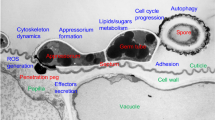Summary
Firm adhesion of fungal plant pathogens to their hosts is critical at several stages in the host-parasite interaction. Spores of many fungal species are capable of rapid, non-specific attachment to various surfaces. This early adhesion, which often occurs well before germ tube emergence, prevents spores from being blown or washed from the host surface before infection can take place. Adhesion is critical for proper sensing of topographic signals involved in thigmotropic responses and for differentiation and function of appressoria. Four fungal pathogens which exhibit a variety of adhesion mechanisms have been selected for discussion.
Similar content being viewed by others
Abbreviations
- EMC:
-
extracellular matrix
- FSTEM:
-
freeze-substitution transmission electron microscopy
- Con A:
-
concanavalin A
- CryoSEM:
-
cryo scanning electron microscopy
- MTM:
-
macroconidial tip mucilage
- STM:
-
spore tip mucilage
References
Aist JR (1981) Development of parasitic conidial fungi in plants. In: Cole GT, Kendrick B (eds) Biology of conidial fungi, vol 2. Academic Press, New York, pp 75–110
Beckett A, Woods AM (1987) The pattern of colony development and the formation of the uredinium ofUromyces viciae-fabae onVicia faba. Can J Bot 65: 1998–2006
—, Tatnell JA, Taylor N (1990) Adhesion and pre-invasion behaviour of urediniospores ofUromyces viciae-fabae during germination on host and synthetic surfaces. Mycol Res 94: 865–875
Bourett TM, Howard RJ (1990) In vitro development of penetration structures in the rice blast fungusMagnaporthe grisea. Can J Bot 68: 329–342
—, Picollelli MA, Howard RJ (1993) Postembedment labeling of intracellular concanavalin A-binding sites in freeze-substituted fungal cells. Exp Mycol 17: 223–235
Braun EJ, Howard RJ (1994) Adhesion ofCochliobolus heterostrophus conidia and germlings to leaves and artificial surfaces. Exp Mycol (in press)
Ceasar-TonThat TC, Epstein L (1991) Adhesion-reduced mutants and the wild-typeNectria haematococca: an ultrastructural comparison of the macroconidial walls. Exp Mycol 15: 193–205
Clement JA, Martin SG, Porter R, Butt TM, Beckett A (1993 a) Germination and the role of extracellular matrix in adhesion of urediniospores ofUromyces viciae-fabae to synthetic surfaces. Mycol Res 97: 585–593
—, Butt TM, Beckett A (1993 b) Characterization of the extracellular matrix produced in vitro by urediniospores and sporelings ofUromyces viciae-fabae. Mycol Res 97: 594–602
Deising H, Nicholson RL, Haug M, Howard RJ, Mendgen K (1992) Adhesion pad formation and the involvement of cutinase and esterases in the attachment of uredospores to the host cuticle. Plant Cell 4: 1101–1111
Emmett RW, Parbery DG (1975) Appressoria. Annu Rev Phytopathol 13: 147–167
Epstein L, Laccetti LB, Staples RC, Hoch HC (1987) Cell-substratum adhesive protein involved in surface contact responses of the bean rust fungus. Physiol Mol Plant Pathol 30: 373–388
Evans RC, Stempen H (1986) Localization of protein in the hyphal sheath ofBipolaris maydis race T. Phytopathology 76: 792–794
— —, Frasca P (1982) Evidence for a two-layered sheath on germ tubes of three species ofBipolaris. Phytopathology 72: 804–807
Hamer JE, Howard RJ, Chumley FG, Valent B (1988) A mechanism for surface attachment in spores of a plant pathogenic fungus. Science 239: 288–290
Hardham AR (1992) Cell biology of pathogenesis. Annu Rev Plant Physiol Plant Mol Biol 43: 491–526
Hoch HC, Staples RC, Whitehead B, Comeau J, Wolf ED (1987) Signaling for growth orientation and cell differentiation by surface topography inUromyces. Science 235: 1659–1662
Howard RJ, Ferrari MA (1989) Role of melanin in appressorium function. Exp Mycol 13: 403–418
— —, Roach DH, Money NP (1991) Penetration of hard substrates by a fungus employing enormous turgor pressures. Proc Natl Acad Sci USA 88: 11281–11284
Jones MJ, Epstein L (1989) Adhesion ofNectria haematococca macroconidia. Physiol Mol Plant Pathol 35: 453–461
— — (1990) Adhesion of macroconidia to the plant surface and virulence ofNectria haematococca. Appl Environ Microbiol 56: 3772–3778
Kwon YH, Epstein L (1993) A 90 kDa glycoprotein associated with adhesion ofNectria haematococca macroconidia to substrata. Mol Plant Microbe Interact 6: 481–487
Moloshok TD, Leinhos GME, Staples RC, Hoch HC (1993) The autogenic extracellular environment ofUromyces appendiculatus urediospore germlings. Mycologia 85: 392–400
Nicholson RL, Epstein L (1991) Adhesion of fungi to the plant surface: prerequisite for pathogenesis. In: Cole GT, Hoch HC (eds) The fungal spore and disease initiation in plants and animals. Plenum, New York pp 3–23
Read ND (1991) Low-temperature scanning electron microscopy of fungi and fungus-plant interactions. In: Mendgen K, Lesemann D-E (eds) Electron microscopy of plant pathogens. Springer, Berlin Heidelberg New York Tokyo, pp 17–29
Terhune BT, Hoch HC (1993) Substrate hydrophobicity and adhesion ofUromyces urediospores and germlings. Exp Mycol 17: 241–252
—, Bojko RJ, Hoch HC (1993) Deformation of stomatal guard cell lips and microfabricated artificial topographies during appressorium formation byUromyces. Exp Mycol 17: 70–78
Wynn WK, Staples RC (1981) Tropisms of fungi in host recognition. In: Staples RC, Toenniessen GH (eds) Plant disease control: resistance and susceptibility. Wiley, New York, pp 45–69
Author information
Authors and Affiliations
Rights and permissions
About this article
Cite this article
Braun, E.J., Howard, R.J. Adhesion of fungal spores and germlings to host plant surfaces. Protoplasma 181, 202–212 (1994). https://doi.org/10.1007/BF01666396
Received:
Accepted:
Issue Date:
DOI: https://doi.org/10.1007/BF01666396




